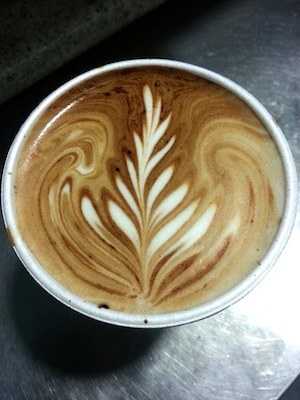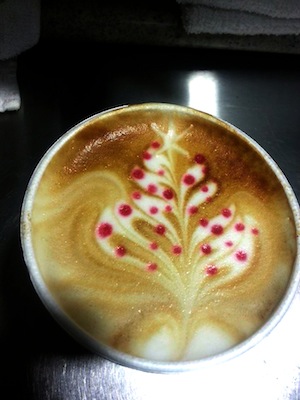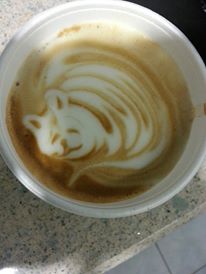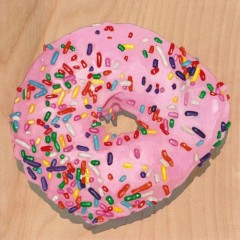Essays Stephen Morehead — January 28, 2014 12:33 — 9 Comments
Somebody Might See You Standing There – Stephen Morehead
Here’s the reason why the top of the mug is a circle: Because every time you take a sip of coffee, it centers you. It brings you back to one spot. The epicenter. The dot in the middle of the page of math homework where lines intersect. It’s the ganglion that allows us to bow our head and bring ourselves together before the nerve tendrils relax and uncurl out to our surroundings and, from there, into the world. That’s why, at the cafe inside the hospital where I work, I drink coffee all day long—because working customer service to several hundred overworked, overstressed residents at the tail end of their eighty-hour work week, and nurses who have just dealt with twelve straight hours of poo, fills the air with electric zigzagged lines going every which direction.
A nurse walks in. She’s a children’s nurse, and so she’s wearing a scrub top with a cartoon duck pattern. Ducks swinging a baseball bat, ducks running with a football, ducks in tutus plié-ing From the self-service steam bar, she heaps a bowl full of chicken, portabella, and spinach pasta, then she balances a cheesy breadstick on top of her noodles. I ring her up and I say, “Four dollars and ten cents.â€
“What?†she says.
“$4.10â€
“I never get charged that much.â€
“Well, you got the main course, which is $3.35 and the bread stick is .75.â€
“It’s not even a full bowl,†she says.
“It’s piled over the top of the bowl,†I say. “I have to charge you for a full serving.â€
“Just forget it then,†she says. She steps to walk as if she’s going to put the food back. But then she stops. She sets the bowl of food on the counter and thrusts her fingers into the bowl of pasta, wiggling them around so the alfredo sauce squishes loudly. Then, looking straight at me, she says, “Guess it just goes to waste, then.†But she doesn’t storm out of the cafe. She walks over to the soup pots and ladles out a bowl of soup, which I ring up.
My favorite drink to make is an Americano. Because I’ve seen the photographs that NASA puts out. I fill up the cup with water that is exactly 201 degrees Fahrenheit, grind coffee into my portafilter, and then pull the espresso onto the water, and the espresso falling onto the water, as it changes in color from deep chocolate to bright red mahogany, is so light and fluffy that it floats on top of the water, though it doesn’t sit there—it’s driven by the same force that drives galaxies: gravity. So while the espresso wants to float like a cloud, like the steam that sneaks off the top of the water, gravity tugs on it all the while and swirls into the arms of the Milky Way. And all the while, the person on the other side of the coffee bar has no idea that this is going on, that galaxies are forming right in front of them while they are waiting for their coffee, talking with their friend or their coworker, or just the next person that is in line behind them, or more often they don’t talk at all but stare ahead of themselves, unblinking as if from the time that they order to the time their drink arrives they live completely inside of their head.
When I order an Americano myself, and it’s handed across the bar to me, sometimes the first thing that I do is sit down with it and skim the crema—the soft, fluffy foam that arises from espresso like the foam on top of a beer—off the top with a spoon and stick it into my mouth, and it’s so light that I can’t feel it in my mouth, it just dissolves, but it still coats my tongue with sweetness, and I’m so thankful for the care that the barista has put into my drink and the training she has received and the years that espresso philosophers have spent scratching their heads over temperatures, bars of pressure, serving wear, burrs, roasts, and soils.
When I pull espresso into an Americano, I watch it bloom.
“Hey! I ordered a medium peppermint mocha?â€
I reach over to my cup, which is sitting next to the espresso machine. I take a drink. All lines come back to me and the cup and to what I’m doing. I don’t look up from the line of espresso falling like honey from a jar into the cup.
I look at my line of drink tickets and say, “I have just a few more drinks ahead of yours.†I say, “We’re pretty busy today.â€
When I make her peppermint mocha, while the espresso pours, I tip a steam wand into a milk pitcher and stretch the milk. It makes a kissing sound; a mother playfully smothering her child. I do this for a few seconds, only until I feel the milk start to warm, and then I plunge the wand deep into the milk and all sound goes away. The milk spins clockwise into a vortex. I let the pitcher rest on the grate of the espresso machine because if I keep holding onto the pitcher, I’ll feel the need to fuss with it and I’ll ruin the milk. Two fingers rest on the side of the pitcher, just as a nurse takes a pulse.
When I take the pitcher away from the wand, I’m still swirling it with my hand, not letting the milk rest and settle. I pour the milk into the cup and the espresso clouds. The foam crema on top shakes but doesn’t break. Midway through the pour I get nervous. I get nervous every time. I’m convinced that it isn’t going to come out right and the milk will gloop out instead of flow. I lower the pitcher, rock it from side to side and perfect rounded pristine white zigzags cut through the sunset colored crema, and now I know that I can finish this pattern either by tapering it gently or towering the pattern into little, stacked lines. These striations are the building blocks to all latte art; the quarks to the crema’s higgs-boson matter creating resistance. With a whip of my hand, I drag a yarn-thin stream of milk through the parallels, bringing them all together into a rosetta.
I place the cup onto the counter, and she has manages to reach and fasten a lid in it without turning her head to look at it. It will always amaze me the number of people who will shove something into their mouths without having first looked at what they shove.
It was months after I started working at this hospital cafe before anyone looked down and noticed the top of their coffee. The first person to notice was what we call a “guest†at the hospital—that is, not an employee, but a patient or a visitor. He had a big barrel chest, a hunting jacket, a three-day beard, and bags under his eyes. I wouldn’t have noticed him had it not been for him noticing his own coffee. He said, “I’ve never actually seen that before!†I looked up from the cup and the steel grate of the espresso machine. He said, “Only in the movies!†I didn’t know what to say to him. I said, “This is the movies.†I immediately regretted it, because what I meant to do was to thank him, and to be in stride with him as he found something magical in the capabilities of human beings.
The next person who noticed was a resident, who interrupted me while I pulled shots of espresso. She said to me, “You know you make the best coffee in town, right?†I looked up and she was standing there with ice-blue eyes and hair parted immediately down the center. Thankfully, she didn’t wait for me to respond, but upon achieving eye contact, was already halfway up the stairs, drink in hand.
Another was an Italian internist. She drinks skim milk lattes, extra hot. She asked me why the milk at the top of her latte was so much different than when someone else makes it, and I started to go into an explanation of texturing milk versus stretching it, milk temperatures and microfilm, and when I realized that I was blabbering and I had lost her with my explanation, I bashfully brought it to a conclusion by saying, “I was trained differently.†When I work, she won’t drink a latte unless I’ve made it, acting very ashamed that a coworker sometimes has to go into the back room to fetch me so that I can make her drink, but what I keep trying to explain to her is that I love making her drink for her, and in fact it’s one of my favorite things to do during the work day, and I secretly get giddy when she tells someone ringing her up that she doesn’t want them to make their drink and that person gets upset, saying something like, “I’ve been in this job for over a year now, I know how to make a cup of fucking coffee.†I smile at my coworker as she says this and think to myself how disappointed I would be if I ordered a cup of coffee, as I have done so many times since I’ve moved to this town, and the thing that I was handed was an indescribable glob of over-steamed milk and under-drawn espresso. And I like that this Italian doctor singles me out to make her drink, because it’s nice to be noticed.
A nurse has come in. “It’s been a long time since I’ve seen you,†I say. She says she has been on vacation in Kenya. She tells me briefly about her vacation. I ask her about her tattoo, a flower on her forearm, and she says she’s spending over ten grand to have it removed because she wants nothing more than to work in the children’s unit, and they won’t allow a nurse to work in the children’s unit with a visible tattoo. She shows it to me, and after the latest treatment I can’t even tell that it has faded. She talks more about her trip to Kenya and setting brick into the walls of what will be a school for girls. I listen and the coffee entering her cup is the color of bricks and the milk is spinning, and she talks more as I take the cup and set it on the counter, tip it with one hand and with the other pull the milk and wipe the steam wand, purge it, give the pitcher of milk one swirl and then pour into the lip of the cup, move the line up into the crema which shoots ripples into it, and then my hand glides back and forth. I say, “I’ve forgotten the difference between an African and an Indian elephant, I know it was taught to me, the difference, something to do with the ears,†I say, “but I don’t remember what it was.†I finish up, saying, “hopefully I got it right, though.â€
I place her caramel latte on the bar in front of her and she looks down to see the head of an elephant staring back at her from the top of her drink, peeking its head through the espresso crema like an actor peeks through the red curtain before the show. And she squeals and clasps her hands in front of her chest. When she walks away with it in her hand, I’m brainstorming what a tiger might look like at the top of a mug.
It’s all because when I moved to this town, I didn’t stop drinking coffee. Coffee has been a large portion of my day for years, if not in the foreground then in the background. It’s there as I am reading a book or sitting at the table in the morning and talking to my loved one while the dog is trying to steal leftover pancakes, while I’ve been stuck at any of my previous jobs or waiting at the airport to visit some place for the first time, and so when I’m not here anymore, but somewhere else entirely, a cup of coffee can tell me that I’m still where I stand and breathe. So I make every cup of coffee as I wish others would make it for me; it’s the golden rule that mother told us when we were children, and I make it that way even when I know that the person receiving the coffee doesn’t care, after I’ve listened to milk burning from the hand of a coworker and I knew that the person who received their burnt milk coffee would be as happy with that as they would be with something I made, because I know that someday, someone will care. When I moved here, I was the person who cared. And I often think that nothing can be more displacing than standing in a cafe in a hospital when you know that someone is waiting for you in a room upstairs and jagged little lines are shooting towards their room and your pocket book and the time that you’re taking off of work. Most cups of coffee are like flower petals floating on the river, but some of them bring you back to the center.
9 Comments
Leave a Reply
The answer isn't poetry, but rather language
- Richard Kenney








Stephen, you make beautiful (and I’m sure delicious) coffee. Thanks for sharing. Glad there are at least a few people that appreciate your talent and thoughtfulness!
Thank you, Charlotte! I hope I get to make some coffee for you someday, though never in a hospital setting. Such kind words, you’ve given to me!
The visual images are beautiful to see, but the audible images are just a beautiful. I felt the ribbons of coffee aroma flexing and curling, calming me as I read this. You are truely talented.
You’re the best, and loved!
I love this! I can almost smell it. And it makes me miss my barista days.
Your beautiful way with words, and seeing the world, will continue to move me until the day I leave this Earth.
Amazing work my friend. You are a true artist. That hospital in Michigan is lucky to have you.
This is incredibly beautiful and brought years to my eyes, I’m a barista myself. So many times I’ve wanted to give up because people don’t notice when I’m standing here. This gives me lots of hope and puts meaning back into my job. Thank you.
Thank you Emma for these kind words, and thank you for reading! It’s hard when it seemlike what you are good at is something that no one cares about. This is especially true when what we are good at is making something for someone else to enjoy. It’s a special moment when someone notices the care and work that we put into their drink, and it also makes me wonder, often, about things that I might be missing and it improves my awareness to the actions of others around me. I hope that, the next time that you feel down and under-appreciated, the next person that you make a drink for has their entire day brightened by the work that you do. Your comment brightened mine.
Stephen,
Been along time since we connected. My website is house-illustration.com
I am also on LinkedIn. I do illustratiion work from coast-to-coast.
Joel Abramson